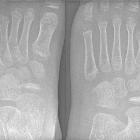navicular fracture








 nicht verwechseln mit: Scaphoidfraktur
nicht verwechseln mit: ScaphoidfrakturNavicular fractures along with cuboid fractures form the most common isolated mid-foot fractures.
Clinical presentation
May present with pain, swelling or hematoma directly over the mid-foot. Stress fractures in athletes and construction workers may present with vague pain and swelling over the mid-foot which worsens with exercise. Patients generally have normal range of motion and a normal neurovascular examination .
Pathology
The fracture occurs via two main mechanisms:
- chronic overuse injuries causing a stress fracture (often in athletes)
- acute trauma
Classification
The Sangeorzan classification is used to assess the severity of isolated navicular fractures and to determine management:
- type I: the fracture line is in the coronal plane and there is no angulation of the forefoot
- type II: the fracture line is dorsal-lateral to plantar-medial and the forefoot is medially displaced
- type III: there is a comminuted fracture in the sagittal plane and the forefoot is displaced laterally
Radiographic features
Plain radiograph
Plain radiographs are the best initial test in a suspected navicular fracture. Their sensitivity for identifying navicular fracture is low, however lateral and oblique radiographs provide the greatest chance of identifying a fracture. Rarely fractures of an accessory navicular bone (if present) are also possible and may be visible.
CT
CT is more sensitive for identifying navicular fractures. It also allows for the assessment of the extent of the fracture line and the degree of communition.
MRI
- T2: may demonstrate areas of hyperintensity over the fracture site indicating bone edema
It should be noted that MRI is more sensitive than CT however in identifying stress fractures .
Treatment and prognosis
Displaced type I and II fractures typically require open reduction and internal fixation with screw lag fixation. Type II fractures require open reduction and internal fixation followed by external fixation. Undisplaced fractures can be managed conservatively in a cast .
Siehe auch:
und weiter:

 Assoziationen und Differentialdiagnosen zu Fraktur Os naviculare pedis:
Assoziationen und Differentialdiagnosen zu Fraktur Os naviculare pedis:

